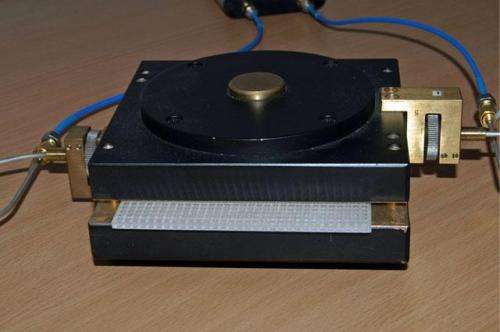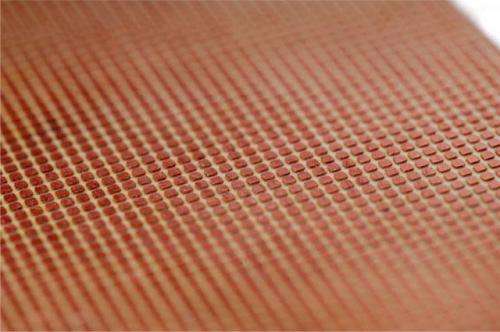Efficient additive manufacture of heterogeneous substrate structures

A '3D printing' manufacturing technique that allows the creation of substrates with three dimensional structures of varying permittivity, from a single material, promises to provide RF designers with a new bag of tools.
Uniform foundations
With the common use of high speed simulation software capable of running thousands of antenna geometries overnight, enhancing EM performance through changing the shape of the metal alone is being thoroughly explored. As a result, attention is turning to alternative paths of exploration.
Current antennas are typically printed on substrates and their behaviour is defined by the properties of the substrate. Antennas with homogenous substrates are generally limited by the availability of substrates with specific thicknesses and electrical properties.
But the electric fields in the substrate of an antenna are not uniformly distributed, so the only reasons for using a uniform substrate are convention and ease of manufacture. If antenna designers are allowed to specify the local parameters of the substrate, this gives them extra degrees of freedom to achieve better performance, especially in the face of increasingly compact and challenging environments. The key limit on this is the ability to manufacture heterogeneous substrate structures, to order, in a way that is practical in terms of costs and complexity.
Variety through structure
There have been relatively few reported works in this area, typically involving modifying the substrate through drilling large numbers of holes and combining multiple layers of substrate. This approach is very labour intensive and the EM advantages obtained have not been sufficient to justify the effort and complexity.

In a Letter in this issue, a team from the University of Loughborough, UK, have demonstrated that different permittivity values can be achieved from a single build material; using additive manufacturing ('3D-printing') technology to create small air inclusions in the material. "As long as these inclusions are small compared to wavelength, an effective permittivity of the mixture can be obtained. Therefore, by varying the size of the air voids or by changing the periodicity, the local permittivity can be controlled" explained team member Dr William Whittow.
The additive manufacturing technique used works by selectively curing a liquid photopolymer with a UV laser. Using an additive technique allows complex geometries to be exported as CAD data directly from EM simulation software, simplifying the design and manufacturing process. The technique is very versatile, allowing the size or spacing of the inclusions to be easily controlled in all three dimensions, which means graded substrates can be fabricated in one process. It also allows the creation of tailored anisotropic substrates, where the effective permittivity depends on the polarisation of the incident electric field. This provides the RF designer with a set of tools to achieve the control they want.
"Varying the permittivity locally in three dimensions to create contoured substrates allows fine-tuning of the antenna behaviour where bespoke substrates can be designed for specific antennas. This ability to control the EM waves can launch a new facade to antenna design," said Whittow. The Loughborough team have previously demonstrated that heterogeneous substrates can increase bandwidth by combining antenna modes, increase antenna efficiency and that three-dimensionally structured substrates can be used to reduce antenna size.
Bending the limits
The manufacturing technique does currently impose a limitation on the size of feature that can be created in the substrate; small holes are needed to allow excess liquid photopolymer to drain away, the minimum size of which is limited by surface tensions and viscosities. This does make the work more applicable for lower frequencies for the moment, but part of the work reported is concerned with how these limits may be altered. Further work is also needed to assess, and then minimise, the loss tangents of these heterogeneous substrates.
The work has involved two of the university's schools; the School of Electronic, Electrical and Systems Engineering; and the School of Mechanical and Manufacturing Engineering; as part of a multidisciplinary effort to fabricate dielectric materials, but this work may also find application in transformation optics. Changing the permittivity of the material also changes its refractive index. So, by grading the local permittivity, EM waves can be bent and controlled in ways that are not possible with conventional homogenous materials. This could be used for cloaking, flat Luneberg lenses or lenses for directive antennas.
There is also work being conducted at Loughborough that would allow the effective permittivity of substrates to be increased, as well as control of the relative permeability. The project, headed by Prof. Yiannis Vardaxoglou, is working to create artificial dielectrics with small metallic inclusions embedded in a 3D lattice. This could lead to higher efficiencies and bandwidths for the same substrate volume.
More information: 'Additively manufactured heterogeneous substrates for three-dimensional control of local permittivity' digital-library.theiet.org/con … 10.1049/el.2014.1174
Journal information: Electronics Letters
Provided by Institution of Engineering and Technology
This story is published courtesy of Electronics Letters. For additional Electronics Letters news and features visit theiet.org/eletters





















